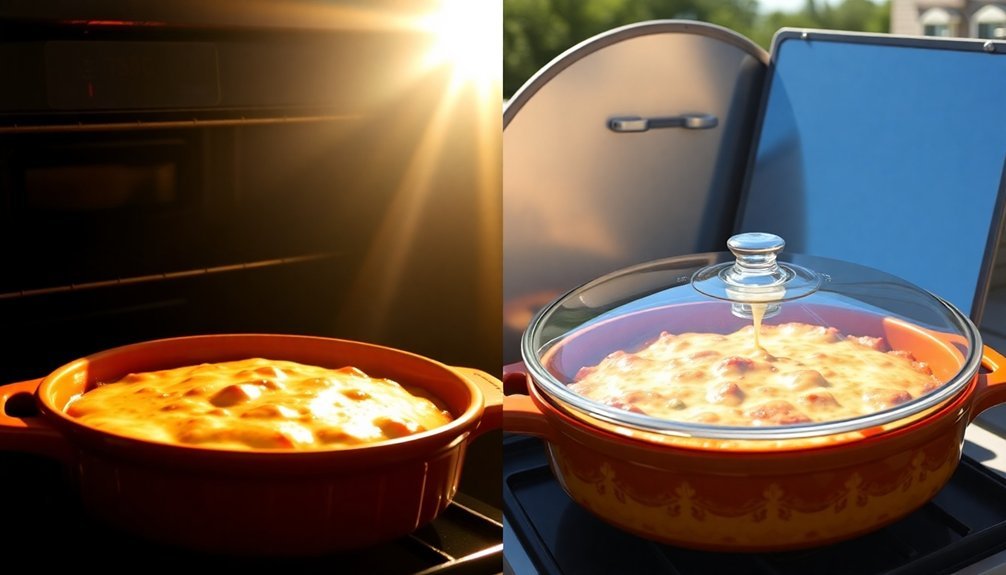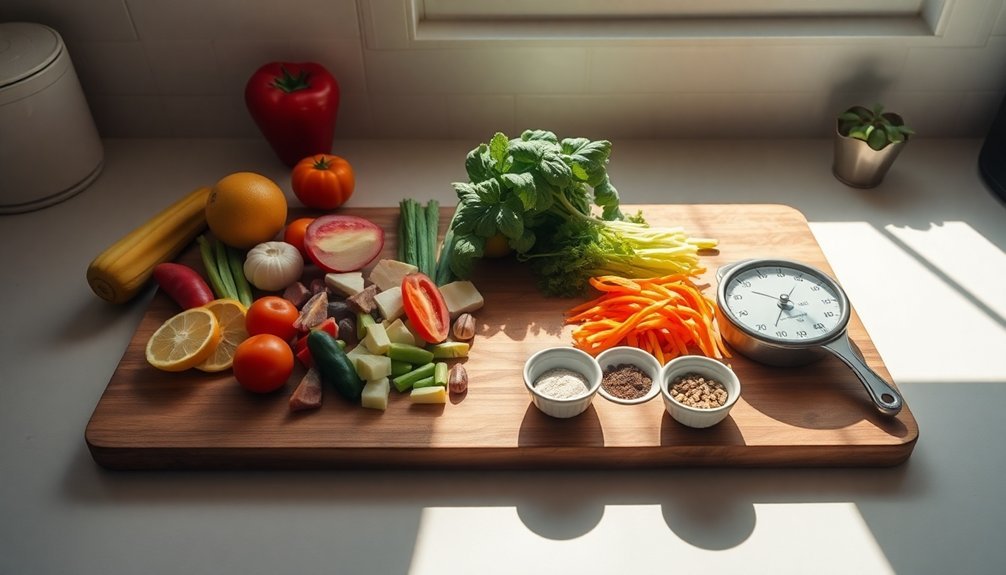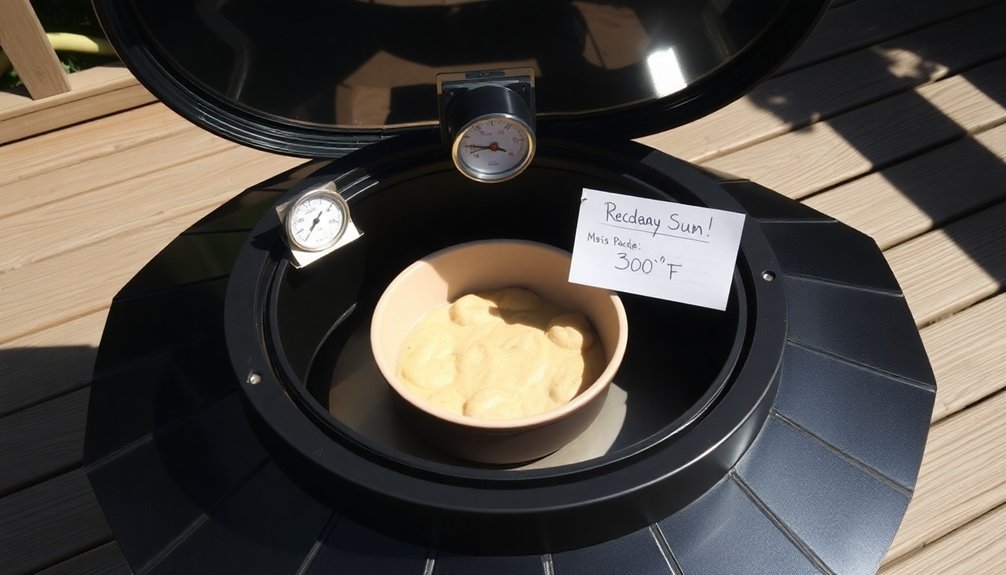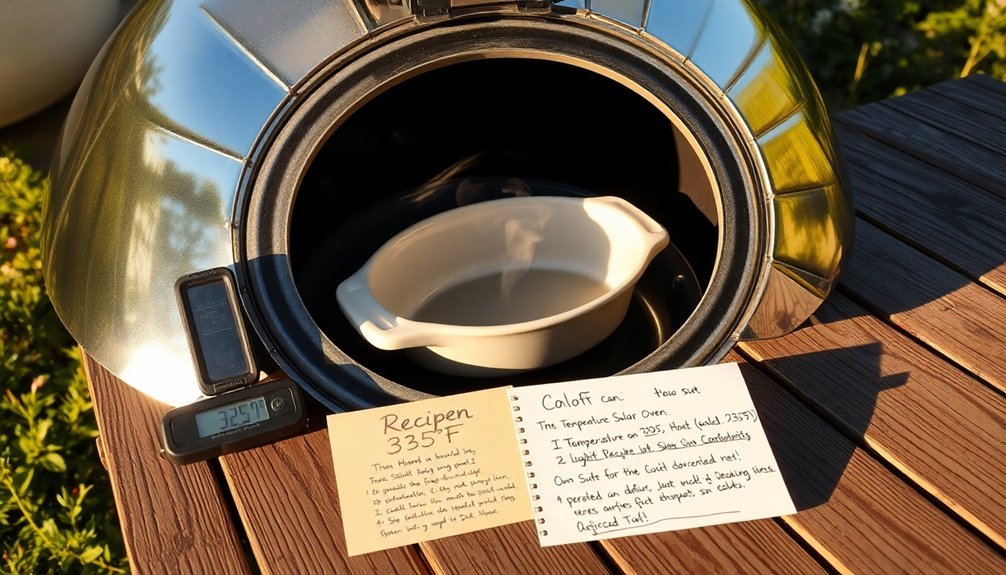When converting recipes for solar cooking, you'll need to make five key adjustments. Start by doubling or tripling standard cooking times, as solar ovens operate more slowly than conventional ones. You'll want to reduce cooking temperatures by about 25-50°F and position your oven to track the sun every 30 minutes. Cut ingredients into smaller pieces than usual to guarantee even cooking, and use dark, covered cookware to maximize heat absorption. For best results, plan your solar cooking between 11:00 AM and 3:00 PM when sunlight is strongest. These fundamental changes will open up a world of sun-powered culinary possibilities.
Temperature Adjustments for Solar Cooking

When converting traditional recipes for solar cooking, understanding temperature ranges and control methods is essential.
You'll need to adjust your expectations since most solar ovens operate between 200°F and 300°F, though some box-type models can reach 350°F. Parabolic cookers can hit temperatures above 800°F, making them suitable for high-heat cooking.
To maintain ideal temperatures, you'll need to position your oven correctly throughout the day. Solar box cookers work exceptionally well in winter conditions due to their superior insulation. Adjust the angle to maximize sun exposure, especially during winter months when the sun sits lower in the sky.
Use reflectors and black cooking pots to boost heat absorption, and verify your oven is protected from wind. For best results, plan your cooking between 11:00 am and 3:00 pm when sunlight is strongest, and be prepared to reposition your oven regularly to follow the sun's path.
Time Management When Sun Cooking
Successful solar cooking requires careful attention to timing and sun patterns throughout the day.
You'll want to start your cooking between 11:00 am and 3:00 pm when the sun is strongest, though you can begin as early as 10:00 am for preheating.
To maximize efficiency, rotate your solar oven every 30 minutes to track the sun's movement.
You'll need to adjust reflectors every two hours and prop your oven at the proper angle using blocks.
Plan for longer cooking times than with conventional ovens, but you can achieve similar results by staying vigilant with adjustments.
Pre-heat your oven for 15-20 minutes before cooking, and consider splitting recipes over two days during shorter seasons.
For best results, use slow-cooker recipes and dark cookware, which typically complete in about six hours. Living in areas with ample sunny days will help ensure more consistent and reliable cooking results throughout the year.
Recipe Modifications for Solar Success

To achieve great results with solar cooking, you'll need to adapt conventional recipes for lower temperatures and longer cooking times. Use these modifications to guarantee your dishes turn out perfectly:
| Food Type | Temperature | Time Adjustment |
|---|---|---|
| Baked Goods | 300-350°F | Double time |
| Soups/Stews | 200-250°F | Add 30-60 mins |
| Vegetables | 250-300°F | Add 45 mins |
| Meats | 275-325°F | Triple time |
Choose black cooking pots to maximize heat absorption and maintain moisture by using covered containers. When cooking liquids, stir every 10 minutes for even heating. Position your solar oven to capture maximum sunlight exposure throughout the cooking period. Pre-cooked foods work especially well in solar ovens, as they only need reheating. Start with simple recipes like cookies or roasted vegetables until you're comfortable with your oven's performance. Remember to monitor internal temperatures with a thermometer to guarantee food safety.
Ingredient Preparation for Solar Ovens
Preparing ingredients properly for solar oven cooking can make the difference between mediocre and exceptional results.
You'll want to cut your ingredients into smaller pieces to reduce cooking time and guarantee even heating throughout your dish.
When preparing meats, marinate them in advance to enhance flavor and improve cooking efficiency.
For vegetables, don't add water; instead, let them cook in their natural juices using a lidded pan.
If you're baking potatoes, rub them with oil and place them in a covered pot, but don't wrap them in foil.
For one-pot meals, cut all ingredients to similar sizes and combine them before placing in the oven.
Remember to stir liquids every 10 minutes and rotate solid foods every 10-15 minutes for uniform cooking.
Pre-heat your solar oven before adding ingredients to speed up the cooking process.
Using dark-colored pans will help maximize heat absorption and ensure your food cooks thoroughly.
Solar Oven Positioning Guidelines

Proper positioning of your solar oven determines its cooking performance and efficiency. You'll want to place it between 11:00 AM and 3:00 PM when sunlight is strongest. Orient the shorter front panel eastward for lunch or westward for dinner, and adjust the position every 20-30 minutes to track the sun.
| Time of Day | Positioning | Wind Protection | Reflector Angle |
|---|---|---|---|
| Morning | East-facing | Use stones/bricks | 45° tilt |
| Midday | Direct south | Add wind barriers | 90° vertical |
| Afternoon | West-facing | Create shelter | 45° tilt |
| Winter | Earlier start | Double protection | Steeper angle |
Keep reflectors clean and properly angled for maximum efficiency. Create an air gap under your pot using a wire rack, and secure all panels with clothespins in windy conditions.
Frequently Asked Questions
Can I Use My Solar Oven on Cloudy or Partly Cloudy Days?
Yes, you can use your solar oven on cloudy days, but it'll take about twice as long to cook your food. While the oven won't reach peak temperatures, it'll still function effectively for slow-cooking meals.
What Materials Should I Avoid Using in My Solar Oven?
You'll want to avoid cardboard, unsealed wood, and paper due to moisture damage. Don't use shiny or light-colored materials, as they won't absorb heat well. Skip glass or thin metals without insulation.
How Do I Prevent Condensation From Dripping Onto My Food?
You'll need to cover your pot with a dark tea towel to absorb moisture, leave the lid slightly ajar, or adjust door latches. For quick fixes, you can briefly vent steam and wipe condensation away.
What Foods Are Unsafe to Cook in a Solar Oven?
You shouldn't cook raw eggs, raw seafood, or unpasteurized dairy in a solar oven. These foods are risky because inconsistent temperatures can promote bacteria growth. Also avoid large meat cuts that heat unevenly.
Can Solar Ovens Be Used Effectively in Cold Winter Months?
Yes, you can use solar ovens effectively in winter months. It's not the outside temperature that matters, but the sunlight's brightness. You'll need to track the sun more frequently and adjust cooking times accordingly.
In Summary
You'll find solar cooking becomes second nature once you master these key adaptations. Remember to reduce temperatures by 25-50 degrees, double your cooking times, adjust liquid quantities, prep ingredients uniformly, and position your oven for ideal sun exposure. Don't let cloudy days discourage you – with practice and these guidelines, you'll transform traditional recipes into solar-powered successes that preserve both energy and flavor.





Leave a Reply